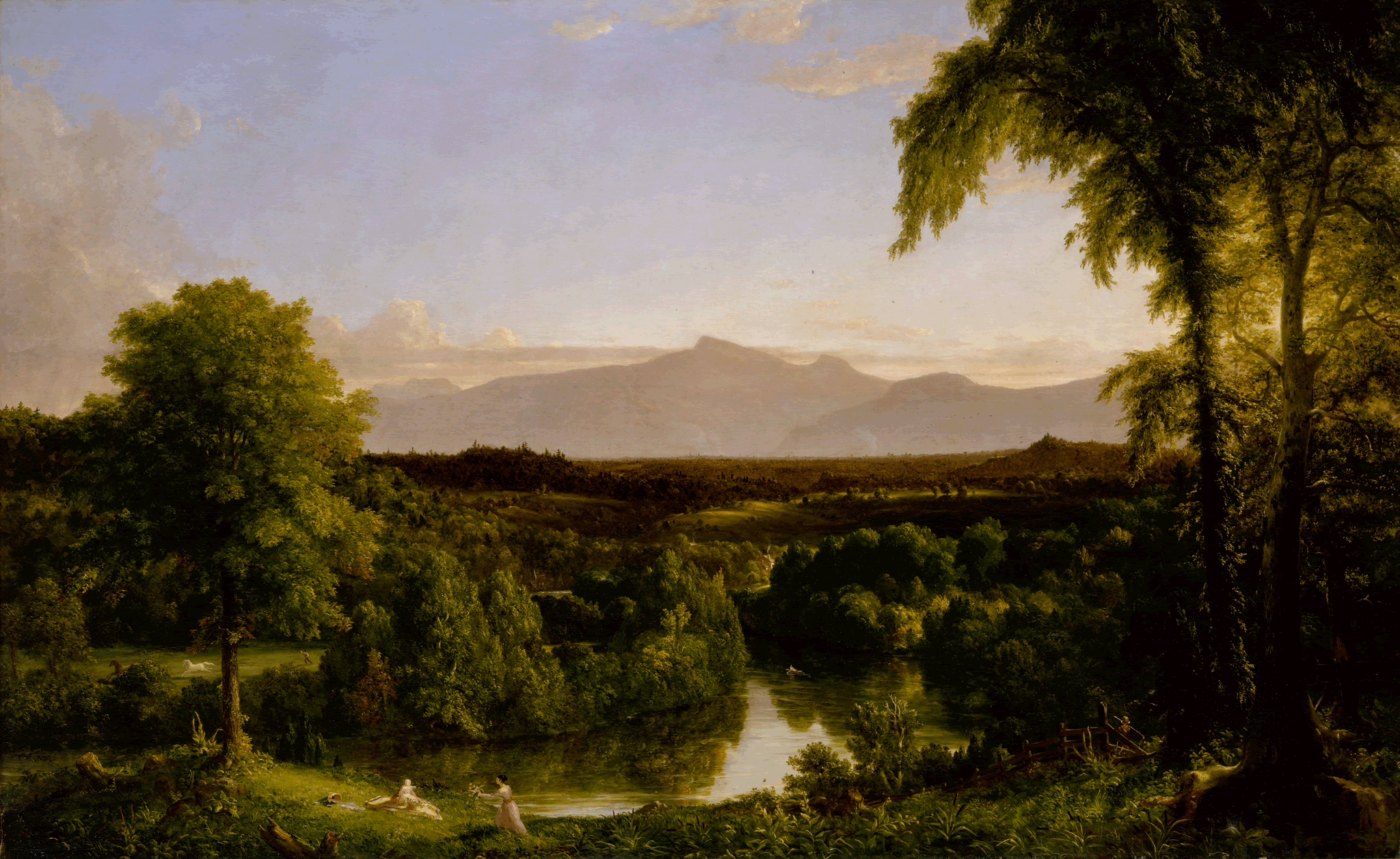View on the Catskill, Early Autumn

About
Decode
Compare
Cole's Process
Cole's Words
Locate
About
Cole painted View on the Catskill, Early Autumn in response to the destruction of his beloved Catskill scenery when construction began on the Canajoharie & Catskill Railroad in 1836. By then he was a full-time resident at Cedar Grove. In a letter to his patron Luman Reed, explaining the deforestation around Catskill Creek, Cole wrote:
The copper-hearted barbarians are cutting all the trees down in the beautiful valley on which I have looked often with a loving eye—this throws quite a gloom over my spring anticipations—tell this to Durand, not that I wish to give him pain, but that I want him to join with me in maledictions on all dollar-godded utilitarians. 1
View on the Catskill, Early Autumn is apparently unaffected by this destruction; instead, Cole depicts Catskill Creek as it appeared before the railroad came through. This peaceful pastoral view is therefore nostalgic, while at the same time warning that nature's beauty can be destroyed in the name of progress. 2 The happy citizens in the foreground of the painting, finding simple enjoyment in the landscape, are symbolic of a healthy relationship between human beings and the natural environment, one which Cole hoped would be preserved despite the onslaught of technology. One sign of warning, however, is the tree stump at the left, clearly cut by human hands. 3
Decode
Mouse over the detail to view its caption, click it to zoom in, and use the reset button on the lower right to zoom back out.
1. Cole could see a similar view of the Catskill Mountains from his porch at Cedar Grove.
2. Horses run from their master in a field, indicating man's weak control over wild animals.
3. A mother brings a bouquet of wildflowers to her baby on the banks of the creek, possibly painted in response to Cole's recent marriage to Maria Bartow.
4. The Van Vechten family's old stone house symbolizes a previous age of rural society in Catskill. The president of the Canajoharie & Catskill Railroadpurchased the house in 1840, and the railroad line eventually ran adjacent to it. See Frederic Edwin Church, The Van Vechten House, Catskill, New York .
5. A man in a rowboat is peacefully enjoying nature's gifts without disturbing them.
6. A hunter stands by a fence looking at the mother and child. Even though this figure may symbolize human control over nature, some historians suggest that, since he wears the same hat as the artist in The Oxbow, he may be another self-portrait.
7. A tree stump felled by an axe conveys Cole's warning that the Catskill scenery is in danger of being destroyed.
Compare
Thomas Cole, River in the Catskills, oil on canvas, 1843, 27 ½ x 40 3/8 in. Museum of Fine Arts (Boston). Gift of Martha C. Karolik for the M. and M. Karolik Collection of American Paintings, 1815-1865, 47.1201. View in Virtual Gallery
Cole painted this work seven years after View on the Catskill, Early Autumn. Historians often consider the two paintings to be pendants, a before-and-after record of Catskill Creek. Whereas View on the Catskillconveys a perfect pastoral ideal, River in the Catskills shows the destruction caused by the Canajoharie & Catskill Railroad. In the background, a railroad bridge cuts through the once-tranquil landscape, and a steam engine with billowing smoke barrels across the river. The maple tree in the left foreground of View on the Catskillhas been cut down and is now a mere stump, while the framing trees at the right have completely disappeared. Much of the dense foliage is now pasture land. A lone man, axe in hand, surveys the scene from the foreground amid branches he has recently cut from a tree. In River in the Catskills, Cole records the troubling transformation of the lovely environment he painted in View on the Catskills, Early Autumn. 1
Process
Cole's process of transforming his field sketches into imaginative landscape compositions is evident in View on the Catskill, Early Autumn. Intent on recapturing the scenic splendor of his beloved Catskill Creek, Cole employed pencil sketches he had made five years earlier to create a nostalgic vision of an era before loggers and railroad builders had spoiled the picturesque beauty of the landscape.
Although remaining faithful to the Catskill topography, Cole adopted the traditional artistic conventions of the pastoral landscape: the framing of foreground trees, the gradual recession into space, the harmonizing of landscape elements, and the golden light that suffuses the scene. He omitted the unsightly changes that had occurred in the years since he had made his sketches. He also added details not present in his sketches, such as the man in the rowboat, the farmer chasing after his horses in the meadow, the woman gathering wildflowers, her baby sitting by the bank of the stream, and the hunter coming into scene at the right. Cole used these symbolic embellishments to evoke a sense of harmony between human society and the natural world. As he wrote in 1836:
Rural nature is... the exhaustless mine from which the poet and the painter have brought such wondrous treasures—an unfailing fountain of intellectual enjoyment, where all may drink, and be awakened to a deeper feeling of the works of genius, and a keener perception of the beauty of our existence. For those whose days are all consumed in the low pursuits of avarice, or the gaudy frivolities of fashion, unobservant of nature's loveliness, are unconscious of the harmony of creation. 1
Works
1. Thomas Cole, Untitled, Landscape Composition, graphite pencil on off-white wove paper, 1832. Detroit Institute of Arts. Founders Society Purchase, William H. Murphy Fund, 39.566.41. View in Virtual Gallery
2. Thomas Cole, Near Catskill, graphite pencil on off-white wove paper, 1832-33. Detroit Institute of Arts. Founders Society Purchase, William H. Murphy Fund, 39.566.45. View in Virtual Gallery
3. Thomas Cole, View on the Catskill, Early Autumn, oil on canvas, 1836-37, 39 x 63 in. Metropolitan Museum of Art. Gift in memory of Jonathan Sturges by his children, 1895, 95.13.3.
Words
"Sunset in the Catskills"
The valleys rest in shadow and the hum
Of gentle sounds and two-tone melodies
Are stilled, and twilight spreads her misty wing
In broader sadness oer their happy scene
And creeps along the distant mountain sides
Until the setting sun's last lingering beams
Wreathe up in golden glorious ring
Around the highest Catskillpeak. 1
"On seeing that a favorite tree of the Author's had been cut down—"
And is the glory of the forest dead?
Struck down? Its beauteous foliage spread
On the base earth? O! ruthless was the deed
Destroying man! What demon urg'd the speed
Of thine unpitying axe? Didst thou not know
My heart was wounded by each savage blow?
Could not the lovliness that did begird
These boughs disarm thine hand and save the bird
Its ancient home and me a lasting joy!
Vain is my plaint! All that I love must die.
But death sometimes leaves hope—friends may yet meet
And life be fed on expectation sweet—
But here no hope survives; again shall spread o'er me
Never the gentle shade of my beloved tree— 2
Find it here.
